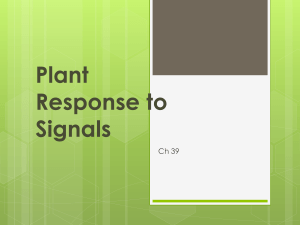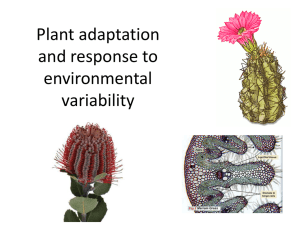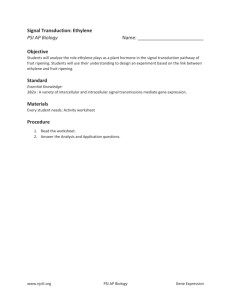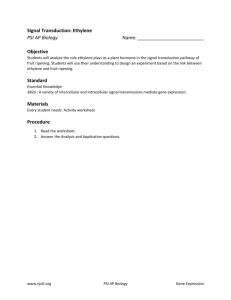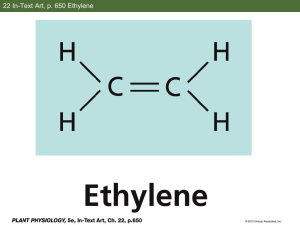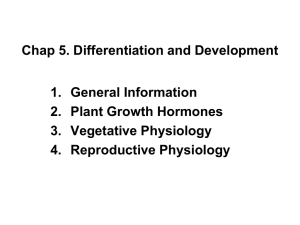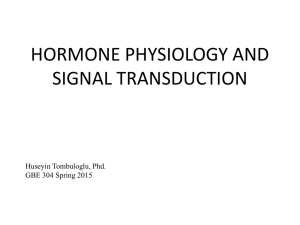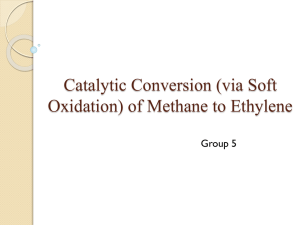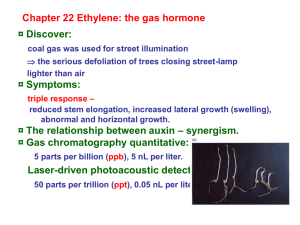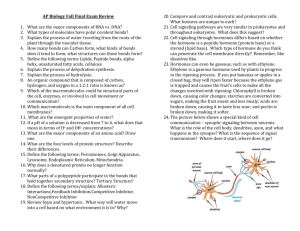Annotated
advertisement
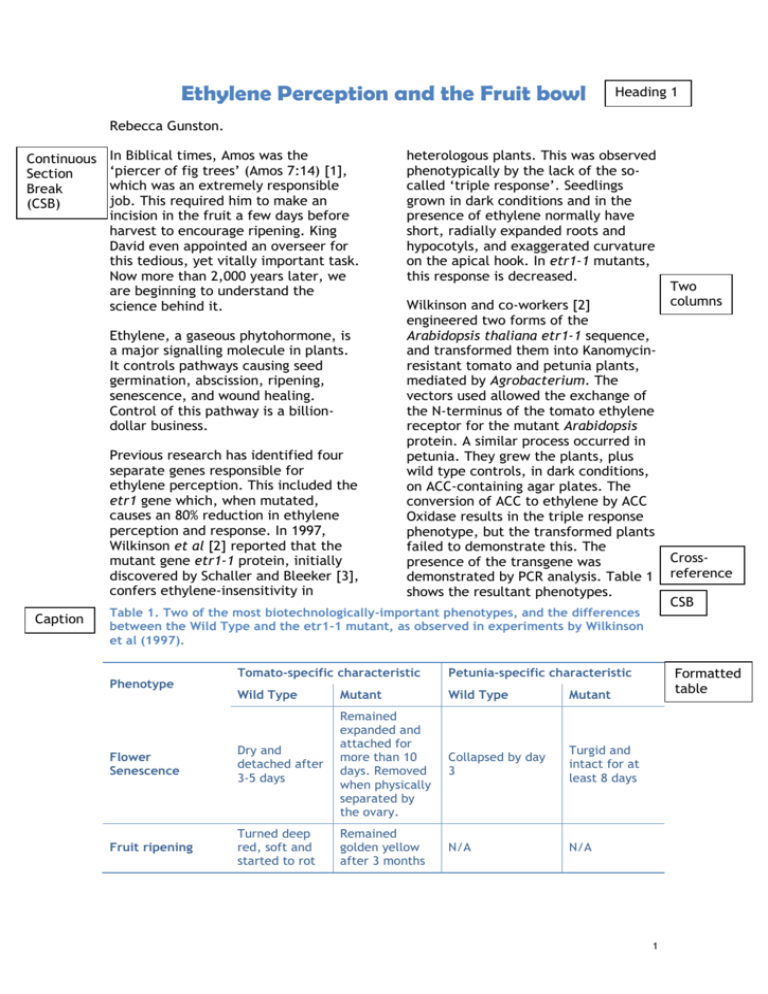
Ethylene Perception and the Fruit bowl Heading 1 Rebecca Gunston. Continuous Section Break (CSB) In Biblical times, Amos was the ‘piercer of fig trees’ (Amos 7:14) [1], which was an extremely responsible job. This required him to make an incision in the fruit a few days before harvest to encourage ripening. King David even appointed an overseer for this tedious, yet vitally important task. Now more than 2,000 years later, we are beginning to understand the science behind it. Ethylene, a gaseous phytohormone, is a major signalling molecule in plants. It controls pathways causing seed germination, abscission, ripening, senescence, and wound healing. Control of this pathway is a billiondollar business. Previous research has identified four separate genes responsible for ethylene perception. This included the etr1 gene which, when mutated, causes an 80% reduction in ethylene perception and response. In 1997, Wilkinson et al [2] reported that the mutant gene etr1-1 protein, initially discovered by Schaller and Bleeker [3], confers ethylene-insensitivity in Caption heterologous plants. This was observed phenotypically by the lack of the socalled ‘triple response’. Seedlings grown in dark conditions and in the presence of ethylene normally have short, radially expanded roots and hypocotyls, and exaggerated curvature on the apical hook. In etr1-1 mutants, this response is decreased. Two columns Wilkinson and co-workers [2] engineered two forms of the Arabidopsis thaliana etr1-1 sequence, and transformed them into Kanomycinresistant tomato and petunia plants, mediated by Agrobacterium. The vectors used allowed the exchange of the N-terminus of the tomato ethylene receptor for the mutant Arabidopsis protein. A similar process occurred in petunia. They grew the plants, plus wild type controls, in dark conditions, on ACC-containing agar plates. The conversion of ACC to ethylene by ACC Oxidase results in the triple response phenotype, but the transformed plants failed to demonstrate this. The Crosspresence of the transgene was demonstrated by PCR analysis. Table 1 reference shows the resultant phenotypes. CSB Table 1. Two of the most biotechnologically-important phenotypes, and the differences between the Wild Type and the etr1-1 mutant, as observed in experiments by Wilkinson et al (1997). Tomato-specific characteristic Petunia-specific characteristic Wild Type Mutant Wild Type Mutant Flower Senescence Dry and detached after 3-5 days Remained expanded and attached for more than 10 days. Removed when physically separated by the ovary. Collapsed by day 3 Turgid and intact for at least 8 days Fruit ripening Turned deep red, soft and started to rot Remained golden yellow after 3 months N/A N/A Phenotype Formatted table 1 The conclusions of this research have several applications for biotechnology. The ethylene pathway is highly conserved between species and the success of Wilkinson et al [2] transgenic experiments indicate that genetic manipulation of the ethylene signalling pathway may be possible in many species, including monocots. It may not be effective at eliminating responses in all plants, but paves the way for the production of crops with a longer shelf life and of better quality, therefore more desirable for consumers, with less wastage for farmers. Its applications in the floriculture industry are also extremely beneficial. Currently, the treatment of flowers with sodium thiosulfate extends their lifetime because it interferes with the ethylene signal pathway. However, it is an environmentally unfriendly method and genetic manipulation will increase flowering time, reducing the cost of cut flower storage, making it more beneficial for consumers. Crossreference Advances in this field of research have been made due to the increased use of genetic manipulation and the use of epistatic analysis to deduce the pathway, as shown in Figure 1. Many questions remain unanswered, the majority relating to specific component-component interactions, or particular component functions, including EIN5, EIN6, EIN7, and the EILfamily. Genetically modified crops are becoming increasingly common-place, despite the continuing debate over their safety. Monsanto recently revealed plans to increase the worldwide area farming transgenic crops by 44%. However, it has been observed that the etr1-1 gene is expressed in a cell-autonomous manner [4]. Nonuniform expression of the transgenic gene will initiate uneven ripening, causing a “distinct ripening sector within an otherwise non-ripening fruit.”[2]. This must be borne in mind when considering the breadth of this technique. Figure 1 taken from Chang and Shockey (1999) [5], demonstrating the current knowledge of the ethylene perception pathway. EIN2 is membrane bound, and thus may associate with the nuclear membrane, although this remains elusive. Caption Two columns The proteins in the ethylene pathway exhibit a high level of redundancy. If it is shown that they are expressed in a tissue-specific manner then mutation of one gene may knockout ethylene perception in one tissue, rather than the whole plant. This may be beneficial for the prevention of ethylene-controlled post-harvest disorders in many crops. It may also be extended to floriculture, crop viability and storage length, and a practicable way of controlling climacteric fruit ripening. Current methods for controlling ethylene activity, such as controlled greenhouse environment, could be successfully combined with gene manipulation to create a reduction in ethylene sensitivity, providing greater control over ethylene-managed processes. This would be more effective than producing completely insensitive mutants that could not be controlled. Nevertheless, ethylene-producing tomatoes, for example, must be physically segregated from crops like lettuces and cucumbers because their ethylene mutation can be reversed in the presence of ethylene. 2 Another cautionary note must be heeded, as deleterious alterations in disease susceptibility to usually nonpathogenic soil fungi, and secondary responses to infection, have been observed in experiments conducted by Chang and Shockey [5]. Other changes to growth, fertility and response to environmental stresses must also be carefully analysed before the use of such GM crops can be considered. After more than two millennia, it appears that Amos’ highly respected job may no longer be necessary. References 1. 2. Theologis, A., One rotten apple spoils the whole bushel: the role of ethylene in fruit ripening. Cell, 1992. 70: p. 181-184. Wilkinson, J.Q., et al., A dominant mutant receptor 3. 4. 5. from Arabidopsis confers ethylene insensitivity in heterologous plants. Nature EndNote Biotechnology, 1997. 15: p. references 444-447. and Schaller, G.E. and A.B. bibliography Bleecker, Ethylene-binding in Numbered sites generated in yeast style expressing the Arabidopsis ETR1 gene. Science, 1995. 270: p. 1809-1811. Tiemann, D.M. and H.J. Klee, Differential expression of two novel members of the tomato ethylene-receptor family. Plant Physiology, 1999. 120: p. 165172. Chang, C. and J.A. Shockey, The ethylene-response pathway: signal perception to gene regulation. Current Opinion in Plant Biology, 1999. 2: p. 352-358. CSB This CSB places the final page in two columns, finishing the references neatly. 3
